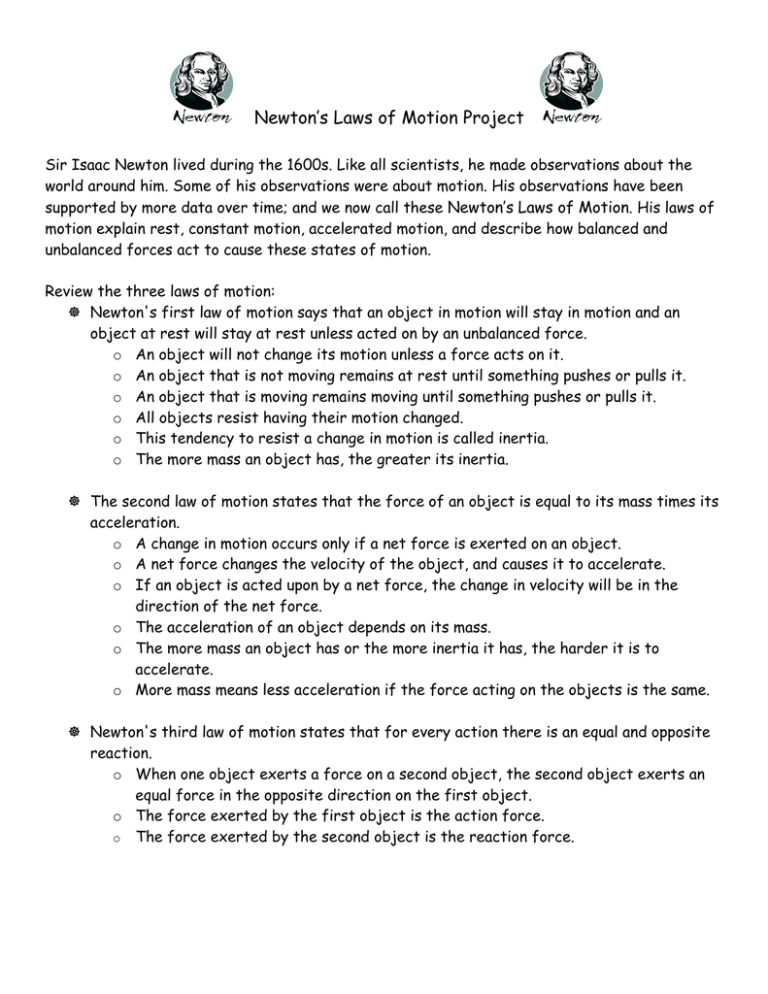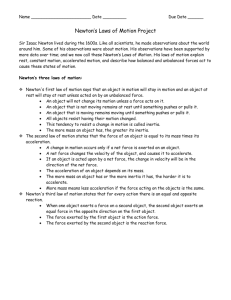Newton`s Laws of Motion Project
advertisement

Newton’s Laws of Motion Project Sir Isaac Newton lived during the 1600s. Like all scientists, he made observations about the world around him. Some of his observations were about motion. His observations have been supported by more data over time; and we now call these Newton’s Laws of Motion. His laws of motion explain rest, constant motion, accelerated motion, and describe how balanced and unbalanced forces act to cause these states of motion. Review the three laws of motion: Newton's first law of motion says that an object in motion will stay in motion and an object at rest will stay at rest unless acted on by an unbalanced force. o An object will not change its motion unless a force acts on it. o An object that is not moving remains at rest until something pushes or pulls it. o An object that is moving remains moving until something pushes or pulls it. o All objects resist having their motion changed. o This tendency to resist a change in motion is called inertia. o The more mass an object has, the greater its inertia. The second law of motion states that the force of an object is equal to its mass times its acceleration. o A change in motion occurs only if a net force is exerted on an object. o A net force changes the velocity of the object, and causes it to accelerate. o If an object is acted upon by a net force, the change in velocity will be in the direction of the net force. o The acceleration of an object depends on its mass. o The more mass an object has or the more inertia it has, the harder it is to accelerate. o More mass means less acceleration if the force acting on the objects is the same. Newton's third law of motion states that for every action there is an equal and opposite reaction. o When one object exerts a force on a second object, the second object exerts an equal force in the opposite direction on the first object. o The force exerted by the first object is the action force. o The force exerted by the second object is the reaction force. Newton’s Law Project (option A) Where can you find Newton’s three Laws? This project allows you find it in magazines and real life. Your task is to make a book of the Newton’s laws using, at the smallest, 8.5 by 11 inch paper (notebook size) which you will fold in half to make a “book” out of. Procedure: 1. First, you will need to state each law as it is written in your textbook or other source. 2. Then find at least two pictures that illustrate each law. Pictures can be from magazines, real photographs, and newspapers, and must be printed and cut out if from the internet. The pictures from the internet must be photographs not diagrams or illustrations and cannot already be labeled with forces. The pictures must be in color. 3. Write a paragraph describing how the pictures you choose illustrates the law. The paragraphs must be at least 5 sentences. Please make sure your references are school appropriate. Page 1……..Cover Page…….Title of Project Your name/s Your hour # Date Page 2 and 3……..1st Law…….. State Newton’s 1st Law Two pictures illustrating the law One paragraph for each picture describing how the picture illustrates Newton’s 1st law. Page 4 and 5……..2nd Law…….. State Newton’s 2nd Law Two pictures illustrating the law One paragraph for each picture describing how the picture illustrates Newton’s 2nd law. Page 6 an 7……..3rd Law…….. State Newton’s 3rd Law Two pictures illustrating the law Draw arrows on your pictures, indicating action and reaction force pairs on the actual pictures. One paragraph for each picture describing how the picture illustrates Newton’s 3rd law. Newton’s Laws Project (option B) Your task is to make a PowerPoint presentation of the Newton’s laws using Microsoft PowerPoint or an equivalent computer program. Procedure: 1. First, you will need to state each law as it is written in your textbook or other source. 2. Then find at least two pictures or video segments that illustrate each law and copy them to a PowerPoint slide; one picture per slide. Pictures or video segments can be from any internet source or digital media that is school appropriate. The pictures must be photographs not diagrams or illustrations and cannot already be labeled with forces. The pictures must be in color. Beware of using video segments or links, some of them may not work on school computers, therefore you may want to try them on school grounds before placing them in your project. If I cannot access them from school your grade will reflect so. 3. Write a paragraph describing how each picture you chose illustrates the law. The paragraphs must be at least 5 sentences and be on the same slide as the picture. Please make sure your references are school appropriate. Slide 1……..Cover Page…….Title of Project Your name Your hour # Date Slide 2 and 3……..1st Law…….. State Newton’s 1st Law Two pictures illustrating the law One paragraph for each picture describing how the picture illustrates Newton’s 1st law. Slide 4 and 5……..2nd Law…….. State Newton’s 2nd Law Two pictures illustrating the law One paragraph for each picture describing how the picture illustrates Newton’s 2nd law. Slide 6 an 7……..3rd Law…….. State Newton’s 3rd Law Two pictures illustrating the law Draw arrows on your pictures, indicating action and reaction force pairs on the actual pictures. One paragraph for each picture describing how the picture illustrates Newton’s 3rd law. Newton’s Laws Project (option C) Your task is to make a Video/Movie presentation of the Newton’s laws using a video camera. In your movie you must follow the following procedure: 1. First, you will need to state each law as it is written in your textbook or other source. 2. Your group must record yourselves accurately demonstrating each of Newton’s Laws. You must have two different demonstrations for each of the three laws. Demonstrations must be school appropriate. 3. After each demonstration there must be an explanation on camera, either while the demonstration is occurring, or after the demonstration, of how each illustrates the law. The explanations must be at least 5 sentences for each demonstration. All group members must in some way be in the video. You can recruit other people to assist in demonstrations. Video Segment 1……..Introduction…….Title of Project Your name Your hour # Date Video Segments 2 and 3……..1st Law…….. State Newton’s 1st Law Two demonstrations of the law One paragraph for each demo describing how the picture illustrates Newton’s 1st law. Video Segment 4 and 5……..2nd Law…….. State Newton’s 2nd Law Two demonstrations of the law One paragraph for each demo describing how the picture illustrates Newton’s 2nd law. Video Segment 6 and 7……..3rd Law…….. State Newton’s 3rd Law Two demonstrations of the law Indicate in your demonstrations action and reaction force pairs. One paragraph for each demo describing how the picture illustrates Newton’s 3rd law. Newton's Three Laws Name__________________________ Points Available Book/Video/ Quality of Slideshow format st 1 Law nd 2 Law Law Stated 3 Law 7 Visually organized, all information is presented in professional manner, fulfills expectations 5 Missing some information, a little unorganized, little creativity 2 Law is stated, but inaccurate 8 Both pictures present and appropriately illustrate law 6 Both pictures present, but 1 or both may not accurately illustrate law 2 Only one picture present, but it appropriately illustrates law Paragraph 8 Complete paragraph with no grammatical errors or spelling errors, Accurately describes how both selected pictures relate to 1st Law 4 Minor errors in accuracy Or Major spelling and grammatical errors Law Stated 2 Pictures 4 Law is stated Accurately 6 Complete paragraph with no grammatical errors or spelling errors, but accurately describes how only one selected picture relate to 1st Law Or Only minor spelling or grammatical errors 2 Law is stated, but inaccurate 6 Both pictures present, but 1 or both may not accurately illustrate law 6 Complete paragraph with no grammatical errors or spelling errors, but accurately describes how only one selected picture relate to 2nd Law Or Only minor spelling or grammatical errors 2 Law is stated, but inaccurate 6 Both pictures present, but 1 or both may not accurately illustrate law Or Perfect, but arrows missing Law Stated 2 Pictures 8 Both pictures present and appropriately illustrate law 8 Complete paragraph with no grammatical errors or spelling errors, Accurately describes how both selected pictures relate to 2nd Law 4 Law is stated Accurately 8 Both pictures present and appropriately illustrate law. Pictures have arrows accurately depicting action & reaction forces 0 Little to no effort, missing key information 0 Law is not stated 2 Pictures Paragraph rd 10 Easy to read, visually pleasing, powerful images, logical sequencing, appropriate for audience, exhibits originality, no technical problems 4 Law is stated Accurately Peer Evaluation 2 Paragraph present, but does not accurately relate pictures to Newton’s law 0 Pictures not present or not appropriately illustrating law 0 Paragraph not present 0 Law is not stated 2 Only one picture present, but it appropriately illustrates law 4 2 Minor Paragraph errors in present, accuracy but does Or not Major accurately spelling and relate grammatical pictures to errors Newton’s law 0 Pictures not present 0 Paragraph not present 0 Law is not stated 2 Only one picture present, but it appropriately illustrates law 0 Pictures not present Self Evaluation Total Points Earned Paragraph 8 Complete paragraph with no grammatical errors or spelling errors, Accurately describes how both selected pictures relate to 3rd Law 6 Complete paragraph with no grammatical errors or spelling errors, but accurately describes how only one selected picture relate to 3rd Law Or Only minor spelling or grammatical errors 4 Minor errors in accuracy Or Major spelling and grammatical errors 2 Paragraph present, but does not accurately relate pictures to Newton’s law 0 Paragraph not present


